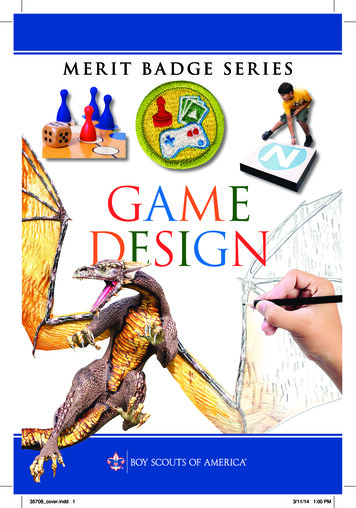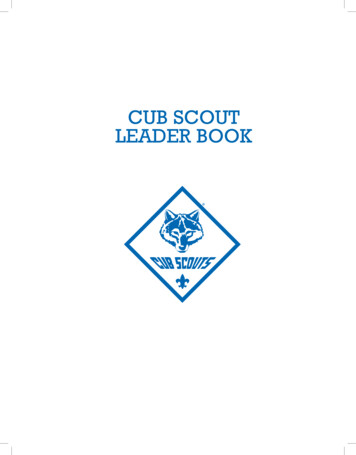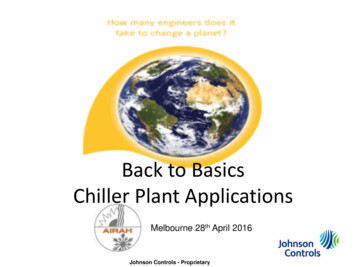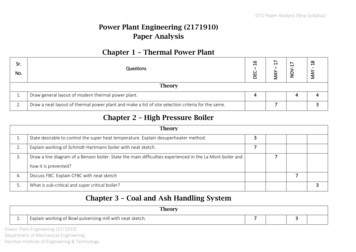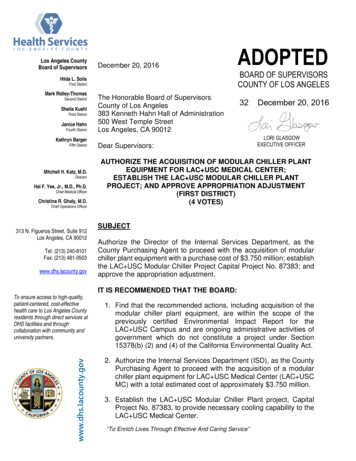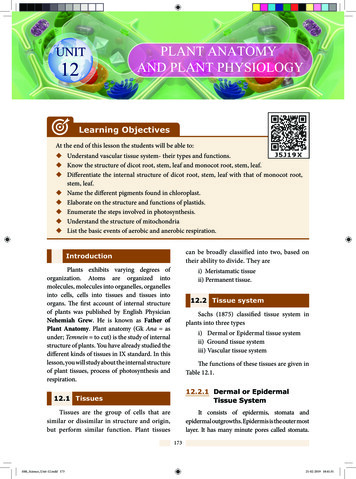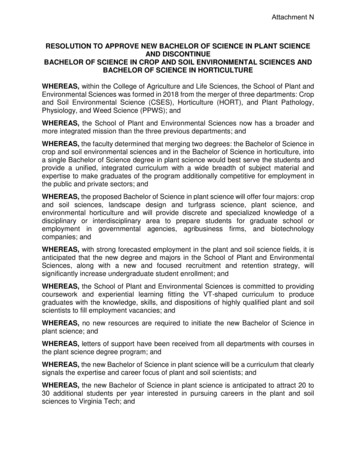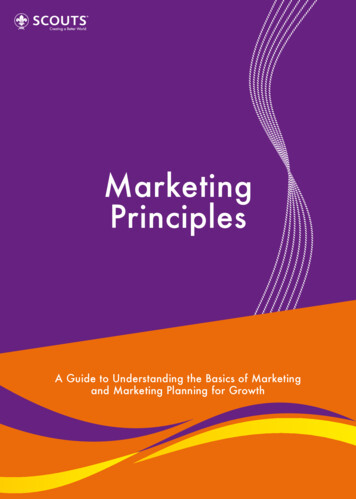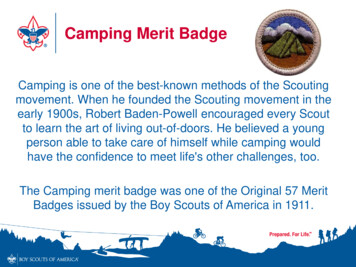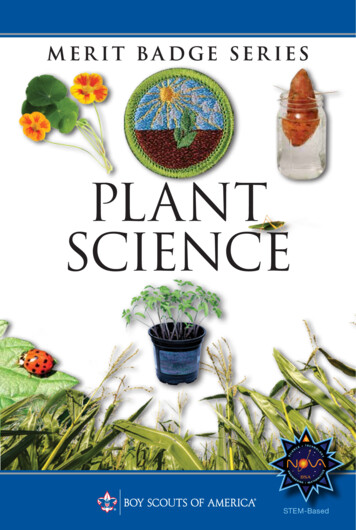
Transcription
PLANTSCIENCESTEM-Based
BOY SCOUTS OF AMERICAMERIT BADGE SERIESPLANT SCIENCE“Enhancing our youths’ competitive edge through merit badges”
Plant Science1. Make a drawing and identify five or more parts of a flowering plant. Tell whateach part does.2. Explain photosynthesis and tell why this process is important. Tell at least fiveways that humans depend on plants.3. Explain how honeybees and other pollinating insects are important toplant life.4. Explain how water, light, air, temperature, and pests affect plants. Describe thenature and function of soil and explain its importance. Tell about the texture,structure, and composition of fertile soil. Tell how soil may be improved.5. Tell how to propagate plants by seeds, roots, cuttings, tubers, and grafting.Grow a plant by ONE of these methods.6. List by common name at least 10 native plants and 10 cultivated plants thatgrow near your home. List five invasive nonnative plants in your area and tellhow they may be harmful. Tell how the spread of invasive plants may beavoided or controlled in ways that are not damaging to humans, wildlife, andthe environment.7. Name and tell about careers in agronomy, horticulture, and botany. Write aparagraph about a career in one of these fields that interests you.8. Choose ONE of the following options and complete each requirement:Option 1: AgronomyA. Describe how to prepare a seedbed.B. Make and use a seed germination tester to test 50 seeds of four of thefollowing plants: corn, cotton, alfalfa, soybeans, clover, wheat, rice, rye,barley. Determine the percentage of live seeds.C. Tell about one important insect pest and one important disease thatdamage each of the following: corn, small grains, cotton. Collect andname five weeds that compete with crops in your locality. Tell how tocontrol these weeds without harming people, wildlife, or useful insects.D. On a map of the United States, identify the chief regions where corn,cotton, forage crops, small grain crops, and oil crops grow. Tell howclimate and location of these regions make them leaders in the productionof these crops.E. Complete ONE of the following alternatives:(1) Corn(a) Grow a plot of corn and have your plot inspected by yourcounselor. Record seed variety or experimental code number.
(b) Tell about modern methods of commercial corn farming and thecontributions that corn makes to today’s food and fuel supply.(c) Tell about an insect that can damage corn, and explain how itaffects corn production and how it is controlled.(2) Cotton(a) Grow a plot of cotton and have your plot inspected byyour counselor.(b) Tell about modern methods of commercial cotton farming, andabout the uses of cotton fiber and seed and the economic value ofthis crop.(c) Tell about an insect that can damage cotton, and explain how itaffects cotton production and how it is controlled.(3) Forage Crops(a) Collect, count, and label samples of each for display: perennialgrasses, annual grasses, legumes, and broadleaf weeds. Indicate howeach grass and legume is used. Keep a log of the site where you foundeach sample and share it with your counselor.(b) Explain how legumes can be used to enrich the soil and how theymay deplete it under certain conditions. Explain how livestock mayenrich or deplete the soil.(c) Name five poisonous plants that are dangerous to livestock,and tell the different ways of using forage crops as feed for livestock.(4) Small Grains(a) Give production figures for small grain crops listed in the U.S.Statistical Report or Agricultural Statistics Handbook for the latestyear available.(b) Help in harvesting a crop of grain. Tell how to reduce harvestinglosses and about modern methods of growing one small grain crop.(c) Visit a grain elevator, flour mill, cereal plant, feed or seed company. Talk with the operator. Take notes, and describe the processesused and tell your patrol, troop, or class about your visit.(5) Oil Crops(a) Grow a plot of soybeans and have your plot inspected byyour counselor.(b) Tell about modern methods of growing soybeans on a commercialscale, and discuss the contributions soybeans make to our food supply.(c) Explain why a killing frost just after emergence is criticalfor soybeans.Option 2: HorticultureA. Visit one of the following places and tell what you learned about horticulture there: public garden, arboretum, retail nursery, wholesale nursery,production greenhouse, or conservatory greenhouse.
B. Explain the following terms: hardiness zone, shade tolerance, pH,moisture requirement, native habitat, texture, cultivar, ultimate size,disease resistance, habit, evergreen, deciduous, annual, perennial.Find out what hardiness zone you live in and list 10 landscape plantsyou like that are suitable for your climate, giving the common nameand scientific name for each.C. Do ONE of the following:(1) Explain the difference between vegetative and sexual propagationmethods, and tell some horticultural advantages of each. Grow a plantfrom a stem or root cutting or graft.(2) Transplant 12 seedlings or rooted cuttings to larger containers andgrow them for at least one month.(3) Demonstrate good pruning techniques and tell why pruningis important.(4) After obtaining permission, plant a tree or shrub properly in anappropriate site.D. Do EACH of the following:(1) Explain the importance of good landscape design and selection ofplants that are suitable for particular sites and conditions.(2) Tell why it is important to know how big a plant will grow.(3) Tell why slower-growing landscape plants are sometimes a betterchoice than faster-growing varieties.E. Choose ONE of the following alternatives and complete EACH ofthe requirements:(1) Bedding Plants(a) Grow bedding plants appropriate for your area in pots or flatsfrom seed or cuttings in a manufactured soil mix. Explain why youchose the mix and tell what is in it.(b) Transplant plants to a bed in the landscape and maintain thebed until the end of the growing season. Record your activities,observations, materials used, and costs.(c) Demonstrate mulching, fertilizing, watering, weeding, anddeadheading, and tell how each practice helps your plants.(d) Tell some differences between gardening with annuals and perennials.(2) Fruit, Berry, and Nut Crops(a) Plant five fruit or nut trees, grapevines, or berry plants that aresuited to your area. Take full care of fruit or nut trees, grapevines, orberry plants through one season.(b) Prune a tree, vine, or shrub properly. Explain why pruningis necessary.(c) Demonstrate one type of graft and tell why this method is useful.(d) Describe how one fruit, nut, or berry crop is processed for use.
(3) Woody Ornamentals(a) Plant five or more trees or shrubs in a landscape setting. Take fullcare of the trees or shrubs you have planted for one growing season.(b) Prune a tree or shrub properly. Explain why pruning is necessary.(c) List 10 trees (in addition to those listed in general requirement 5above) and tell your counselor how each is used in the landscape.Give the common and scientific names.(d) Describe the size, texture, color, flowers, leaves, fruit, hardiness,cultural requirements, and any special characteristics that make eachtype of tree or shrub attractive or interesting.(e) Tell five ways trees help improve the quality of our environment.(4) Home Gardening(a) Design and plant a garden or landscape that is at least 10 by 10 feet.(b) Plant 10 or more different types of plants in your garden. Tell whyyou selected particular varieties of vegetables and flowers. Take careof the plants in your garden for one season.(c) Demonstrate soil preparation, staking, watering, weeding,mulching, composting, fertilizing, pest management, and pruning.Tell why each technique is used.(d) Tell four types of things you could provide to make your homelandscape or park a better place for birds and wildlife. List the common and scientific names of 10 kinds of native plants that are beneficial to birds and wildlife in your area.Option 3: Field BotanyA. Visit a park, forest, Scout camp, or other natural area near your home.While you are there:(1) Determine which species of plants are the largest and which are themost abundant. Note whether they cast shade on other plants.(2) Record environmental factors that may influence the presence of plantson your site, including latitude, climate, air and soil temperature, soil typeand pH, geology, hydrology, and topography.(3) Record any differences in the types of plants you see at the edge of aforest, near water, in burned areas, or near a road or railroad.B. Select a study site that is at least 100 by 100 feet. Make a list of the plantsin the study site by groups of plants: canopy trees, small trees, shrubs,herbaceous wildflowers and grasses, vines, ferns, mosses, algae, fungi,lichens. Find out which of these are native plants and which are exotic(or nonnative).C. Tell how an identification key works and use a simple key to identify10 kinds of plants (in addition to those in general requirement 5 above).Tell the difference between common and scientific names and tell whyscientific names are important.
D. After gaining permission, collect, identify, press, mount, and label10 different plants that are common in your area. Tell why voucher specimens are important for documentation of a field botanist’s discoveries.E. Obtain a list of rare plants of your state. Tell what is being done to protectrare plants and natural areas in your state. Write a paragraph about one ofthe rare plants in your state.F. Choose ONE of the following alternatives and complete EACH ofits requirements:(1) Tree Inventory Identify the trees of your neighborhood, a park, a section of your(a)town, or a Scout camp. (b) Collect, press, and label leaves, flowers, or fruits to documentyour inventory. (c) List the types of trees by scientific name and give commonnames. Note the number and size (diameter at 4 feet above ground)of trees observed and determine the largest of each species in yourstudy area.(d) Lead a walk to teach others about trees and their value, OR writeand distribute materials that will help others learn about trees.(2) Transect Study(a) Visit two sites, at least one of which is different from the one youvisited for Field Botany requirement 1.(b) Use the transect method to study the two different kinds of plantcommunities. The transects should be at least 500 feet long.(c) At each site, record observations about the soil and otherinfluencing factors AND do the following. Then make a graph orchart to show the results of your studies.(1) Identify each tree within 10 feet of the transect line. (2) Measure the diameter of each tree at 4 feet above the ground,and map and list each tree.(3) Nested Plot (a) Visit two sites, at least one of which is different from the one youvisited for Field Botany requirement 1. Mark off nested plots and inventory two different kinds of(b)plant communities. At each site, record observations about the soil and other(c)influencing factors AND do the following. Then make a graphor chart to show the results of your studies. (1) Identify, measure, and map each tree in a 100-by-100-foot plot.(Measure the diameter of each tree at 4 feet above the ground.) (2) Identify and map all trees and shrubs in a 10-by-10-foot plotwithin each of the larger areas.
(3) Identify and map all plants (wildflowers, ferns, grasses,mosses, etc.) of a 4-by-4-foot plot within the 10-by-10-foot plot.(4) Herbarium Visit(a) Write ahead and arrange to visit an herbarium at a university, park,or botanical garden; OR, visit an herbarium website (with yourparent’s permission).(b) Tell how the specimens are arranged and how they are used byresearchers. If possible, observe voucher specimens of a plant that is rarein your state.(c) Tell how a voucher specimen is mounted and prepared forpermanent storage. Tell how specimens should be handled so that theywill not be damaged.(d) Tell about the tools and references used by botanists in an herbarium.(5) Plant Conservation Organization Visit(a) Write ahead and arrange to visit a private conservation organizationor government agency that is concerned with protecting rare plants andnatural areas.(b) Tell about the activities of the organization in studying andprotecting rare plants and natural areas. If possible, visit a nature preserve managed by the organization.(c)Tell about land management activities such as controlled burning, ormeasures to eradicate invasive (nonnative) plants or other threats to theplants that are native to the area.
Plant Science Resources.Plant Science ResourcesScouting LiteratureFieldbook; Boy Scout Journal; Environmental Science, Gardening, LandscapeArchitecture, Soil and Water Conservation, Insect Study, Forestry, Nature, andSustainability merit badge pamphletsVisit the Boy Scouts of America’sofficial retail website (withyour parent’s permission) athttp://www.scoutstuff.org for acomplete listing of all merit badgepamphlets and other helpfulScouting materials and supplies.BooksBartholomew, Mel. All New SquareFoot Gardening, 2nd ed. CoolSprings Press, 2013.Bryant, Geoff. Plant Propagation A toZ: Growing Plants for Free. FireflyBooks Ltd. 2006.Elzer-Peters, Katie. Beginner’sIllustrated Guide to Gardening:Techniques to Help You Get Started.Cool Springs Press, 2012.Jeavons, John. How to Grow MoreVegetables, 8th ed. Ten SpeedPress, 2012.94 PLANT SCIENCEKujawski, Jennifer. The Week-by-WeekVegetable Gardener’s Handbook:Make the Most of Your GrowingSeason. Storey Publishing, 2011.Madigan, Carleen. The BackyardHomestead: Produce All the FoodYou Need on Just a Quarter Acre!Story Publishing, 2009.Pleasant, Barbara. Starter VegetableGardens: 24 No-Fail Plans forSmall Organic Gardens. StoreyPublishing, 2010.Organizations and WebsitesAmerican Association of BotanicalGardens and ArboretaTelephone: 302-655-7100American Horticultural SocietyWebsite: http://www.ahs.orgATTRA—National SustainableAgriculture Information ServiceWebsite: http://www.attra.ncat.orgBotanical Society of AmericaWebsite: http://www.botany.orgCenter for Invasive Species andEcosystem HealthWebsite: http://www.invasive.orgCenter for Plant ConservationTelephone: 314-577-9450Website: http://www.centerforplantconservation.org
.Plant Science ResourcesEndangered Species ProgramU.S. Fish and Wildlife ServiceWebsite: http://www.fws.gov/endangeredNational FFA OrganizationTelephone: 317-802-6060Website: http://www.ffa.orgNative Plant Information NetworkTelephone: ore/The Nature ConservancyWebsite: http://www.nature.orgUniversity of Florida HerbariumTelephone: riumUSDA Cooperative ExtensionSystem Office Locator MapWebsite: http://nifa.usda.gov/partnersand-extension-mapUSDA National AgriculturalStatistics ServiceWebsite: http://www.nass.usda.govUSDA Plants DatabaseWebsite: http://plants.usda.govU.S. National ArboretumWebsite: http://www.usna.usda.govAcknowledgmentsFor his help in writing this editionof the Plant Science merit badgepamphlet, the Boy Scouts of Americathanks Eagle Scout Jeff Birkby, formercamp ranger and conservationist atPhilmont Scout Ranch.The Boy Scouts of America isgrateful to the men and women servingon the Merit Badge Maintenance TaskForce for the improvements made inupdating this pamphlet.Photo and Illustration CreditsLynn Betts, U.S. Department ofAgriculture, Natural ResourcesConservation Service, courtesy—page 54John D. Byrd, Mississippi StateUniversity, Bugwood.org, courtesy—page 46 (wild mustard)Bill Cook, Michigan State University,Forestryimages.org, courtesy—page 84 (furrowed bark)Steve Dewey, Utah State University,Bugwood.org, courtesy—page 46 (quackgrass)Division of Plant Industry Archive,Florida Department of Agricultureand Consumer Services, Bugwood.org, courtesy—page 45 (smuts)Chris Evans, River to River CWMA,Bugwood.org, courtesy—page 46 (sow thistle)HAAP Media Ltd., courtesy—cover(grasshopper, ladybird beetle)Linda Haugen, USDA Forest Service,Bugwood.org, courtesy—page 30George Markham, USA Forest Service,Bugwood.org, courtesy—page 49(leafy spurge)Paul A. Mistrella, USDA Forest Service,Bugwood.org, courtesy—page 44National Renewable Energy Laboratory/Warren Gretz, courtesy—page 34Dave Powell, USDA Forest Service,Bugwood.org, courtesy—pages 48(locoweed) and 49 (meadowdeath camas) Realworld Imagery Inc.—page 83 (all)R.J. Reynolds Tobacco Company SlideSet, R.J. Reynolds Tobacco Co.,Bugwood.org, courtesy—page 43 (grasshopper)PLANT SCIENCE 95
Plant Science 1.e a drawing and identify five or more parts of a flowering plant. Tell what Mak each part does. 2. Explain photosynthesis and tell why this process is important. . contributions that corn makes to today's food and fuel supply. (c) Tell about an insect that can damage corn, and explain how it affects corn production and how .


